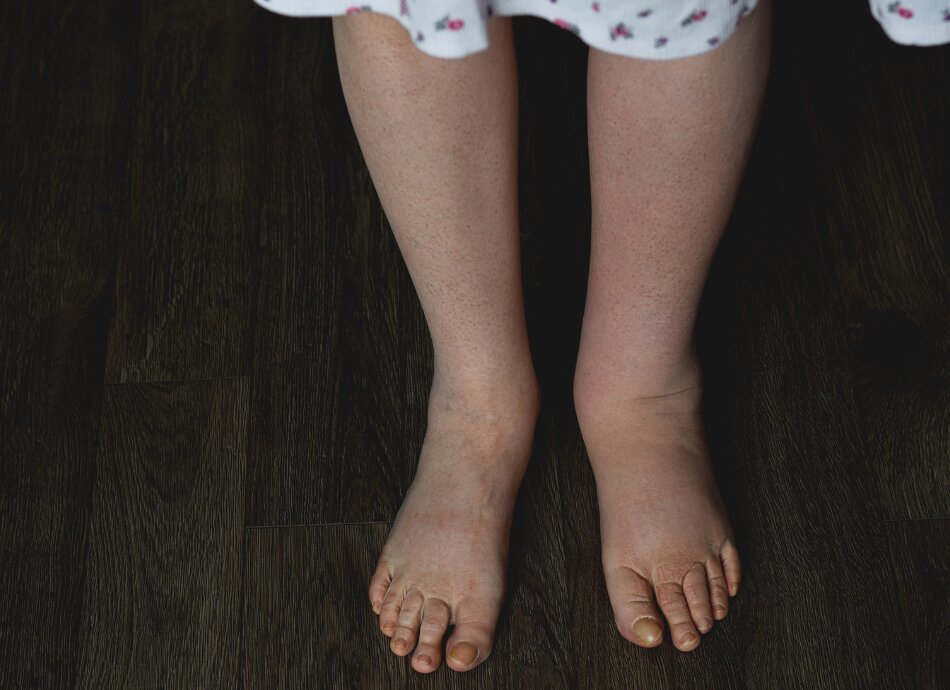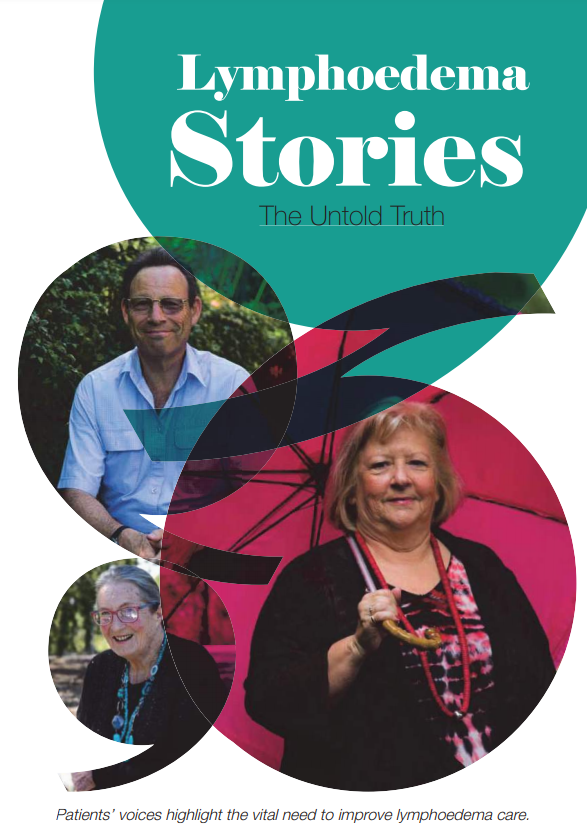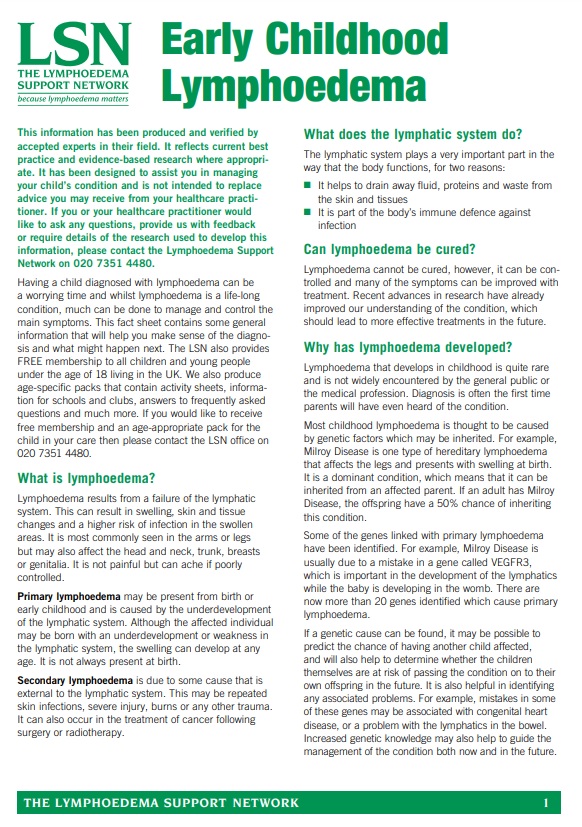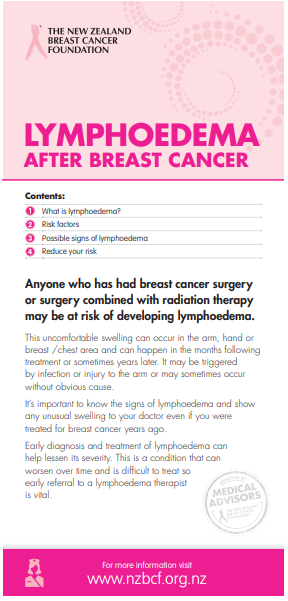Lymphoedema
Key points about lymphoedema
- Lymphoedema is an area of swelling caused by lymph fluid building up in the fatty layer under your skin
- It's caused by your lymphatic system not working properly, generally as a result of injury, surgery or radiation therapy, but it can be genetic.
- Lymphoedema can develop anywhere but most commonly affects your arms or legs.
- It can't be cured, but early diagnosis and treatment can stop or slow its progress.
- Exercising, massage, using compression bandages and maintaining good skin care are important ways to manage the swelling and stop it from getting worse.

The lymphatic system consists of channels and glands that help to fight infection and get rid of excess fluid. Lymphoedema occurs when your lymphatic system is not working properly and fluid builds up under your skin, causing swelling.
There are 2 types of lymphoedema: primary and secondary. Primary lymphoedema (also known as Milroy disease) occurs when your lymphatic system is badly formed. This genetic type can be evident at birth or can appear later.
Secondary lymphoedema results from an event such as an infection, an injury, cancer treatment or a lack of movement of the limbs resulting in a damaged lymphatic system. This then affects fluid drainage.
The main symptom is swelling, probably on all or part of an arm or leg but possibly elsewhere. Other symptoms, which develop at 3 different stages of the condition, can include:
- an achy or heavy feeling
- a change in sensation – pins and needles, shooting pains or feelings of heat
- movement difficulty
- joint discomfort
- hard, tight skin
- folds developing in your skin
- skin infections
- wart-like growths on your skin (in chronic lymphoedema)
- fluid leaking through your skin.
The condition might be present for months or years before any signs of swelling appear. A feeling of heaviness or numbness is likely to be the first symptom.
Stage one – swelling builds up during the day but can be reduced by raising your arm or leg. It is often gone in the morning. At this stage your skin is soft, and pushing it produces a dent that gradually fills in again. With good care, these symptoms can remain stable.
Stage two – your skin is thicker and harder. There is less pitting in your skin and it is more likely to get infected. Again, with the right care, the condition can remain at this stage.
Stage three – there is obvious swelling and toughening of your skin. Skin folds and crevices may develop and the area may leak lymph fluid.
Your doctor can generally diagnose it by asking about your history and by physical examination. For example, a tape measure can be used to compare the circumference of the affected arm or leg with the unaffected arm or leg.
In some cases a test called a lymphoscintigram may be done. This involves using a scanner to track the movement of a radioactive dye through your lymphatic system to check for blockages.
There is no cure for lymphoedema but it can be managed in these ways:
- massage to drain the lymph glands – with training, this can be done by yourself, whānau members or a carer
- wearing a special compression sleeve or bandage for support
- skin care, including moisturisers to maintain softness and ointments to remove dead or hard skin
- gentle exercise to improve lymph drainage.
For more severe swelling, treatment includes:
- specialist massage
- multiple layers of compression bandaging
- possible treatment with benzopyrene medicine
- surgery, but this is rarely done and only for extreme, chronic swelling in specific locations.
The condition will not go away and can get gradually worse. But getting a diagnosis as soon as possible and getting medical help can assist with managing the symptoms.
After breast cancer surgery
A short episode of lymphoedema may be experienced in the days following the surgery. It can also occur 4–6 weeks after surgery or radiation therapy and then go away. The longer lasting type may develop months or years after the lymph nodes have been affected and will not go away. Although there is no sure way to prevent it, women who exercise after treatment and look after their skin well are less likely to develop it.
Lymphoedema from other causes
Unfortunately it is not possible to prevent primary or secondary lymphoedema resulting from other causes. But there are things you can do to manage the symptoms and slow down its development.
Even though the condition will not go away there are plenty of things you can do to keep the symptoms under control and stop them from getting worse.
- Eat a healthy diet, low in fat and high in fibre.
- Drink plenty of water to stay hydrated.
- Try to maintain a healthy weight.
- Do regular exercise like walking or swimming.
- Keep your muscles moving. Along with deep breathing, this will help to stop the fluid building up.
- If your leg is affected, avoid sitting or standing still for long periods of time.
- If your arm is affected, avoid lifting heavy things with that arm. Have injections and blood pressure and blood taken with the other arm.
- Look after your skin by using a soap substitute like aqueous cream that doesn’t dry out your skin.
- Avoid sunburn and very hot showers or baths.
- Wear gloves for gardening and doing dishes.
- If you get insect bites, cuts or abrasions treat them with antiseptic and get them looked at by a health professional if there are any signs of infection (such as pain, redness or heat in the affected limb, red lines extending out from the wound or a general feeling of being unwell).
- If you find yourself worrying or getting depressed about your symptoms, ask for help. Talk to your doctor or nurse who can refer you to a counsellor.
- See if there is a support group in your area, talking to others with the same condition can help.
Apps reviewed by Healthify
You may find it useful to look at some Self-management and healthy living apps and Nutrition, exercise and weight management apps.
- Specialist clinic(external link) in Queenstown
- Support groups(external link) Lymphoedema NZ
- Lymphoedema therapists in NZ(external link) Lymphoedema NZ
- Patient registry of people with lymphoedema(external link) Lymphoedema NZ
- Living with Lymphoedema Australia and New Zealand(external link) A private group Facebook page
- Lymphoedema Breast Cancer App, available through Google Play and iTunes, developed by Australian physiotherapist Kelly Foote
The following links provide further information about lymphoedema. Be aware that websites from other countries may have information that differs from New Zealand recommendations. In the United States the condition is spelled lymphedema.
Childhood and teenage lymphoedema(external link) The Lymphoedema Support Network, UK
Lymphoedema stories – the untold truth(external link) Australasian Lymphology Association, Australia, 2013
Lymphoedema information(external link) Breast Cancer NZ
Lymph Info Trust(external link), facebook page(external link)
Apps
Self-management and healthy living apps
Nutrition, exercise and weight management apps
Resources
Lymphoedema stories – the untold truth(external link) Australasian Lymphology Association, AUS, 2013
Early childhood lymphoedema(external link) The Lymphoedema Support Network, UK, 2022
Teenage lymphoedema(external link) The Lymphoedema Support Network, UK, 2022
Lymphoedema after breast cancer(external link) The New Zealand Breast Cancer Foundation, 2024
References
- Lymphoedema therapists(external link) NZ
- Lymphoedema(external link) NHS, UK, 2019
- Lymphoedema(external link) DermNet, NZ, 2006
Lymphoedema(external link) DermNet NZ, 2006
Australasian Lymphology Association(external link) Australia
A quality of life measure for limb lymphoedema (LYMQOL)(external link) The Open University, UK, 2010
Review article(external link) focused on lymphoedema following breast cancer treatment
A lecture on dietary recommendations for lipoedema and lymphoedema(external link)
Advice for nurses in acute and community settings(external link)
Free online learning course for GPs(external link) The Lymphoedema Support Network, UK
Apps
Self-management and healthy living apps
Nutrition, exercise and weight management apps
Brochures

Australasian Lymphology Association, AUS, 2013

The Lymphoedema Support Network, UK, 2022

The New Zealand Breast Cancer Foundation, 2024
Credits: Healthify editorial team. Healthify is brought to you by Health Navigator Charitable Trust.
Reviewed by: Dr Sharon Leitch, GP and Senior Lecturer, University of Otago
Last reviewed:
Page last updated:





